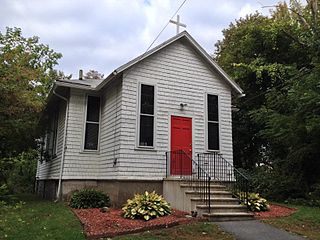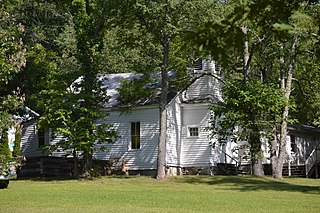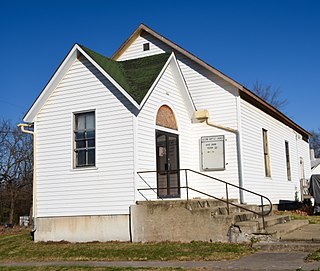The African Union First Colored Methodist Protestant Church and Connection, usually called "the A.U.M.P. Church," is a Methodist denomination. It was chartered by Peter Spencer (1782–1843) in Wilmington, Delaware, in 1813 as the "Union Church of Africans," where it became known as the "African Union Church".
The Methodist Episcopal Church (MEC) was the oldest and largest Methodist denomination in the United States from its founding in 1784 until 1939. It was also the first religious denomination in the US to organize itself nationally. In 1939, the MEC reunited with two breakaway Methodist denominations to form the Methodist Church. In 1968, the Methodist Church merged with the Evangelical United Brethren Church to form the United Methodist Church.

Camp Curtin is a historic neighborhood in Harrisburg, Pennsylvania's northern end, located in Uptown and named for the American Civil War camp of the same name. It is bordered currently by landmarks of Fifth Street to the west, the railroad tracks next to the Pennsylvania Farm Show Complex to the east, Maclay Street to the south, and Reels Lane to the North.

Barratt's Chapel is a chapel located to the north of Frederica in Kent County, Delaware. It was built in 1780 on land donated by Philip Barratt, owner of Barratt Hall, and a prominent local landowner and political figure. Barratt, who had recently become a Methodist, wanted to build a center for the growing Methodist movement in Delaware.
Black Methodism in the United States is the Methodist tradition within the Black Church, largely consisting of congregations in the African Methodist Episcopal (AME), African Methodist Episcopal Zion, Christian Methodist Episcopal denominations, as well as those African American congregations in other Methodist denominations, such as the Free Methodist Church.

The former Nast Trinity United Methodist Church, now known as The Warehouse Church, is a historic congregation of the United Methodist Church in Cincinnati, Ohio, United States. Designed by leading Cincinnati architect Samuel Hannaford and completed in 1880, it was the home of the first German Methodist church to be established anywhere in the world, and it was declared a historic site in the late twentieth century.

The Goodwin Memorial African Methodist Episcopal Zion Church is a historic church on Woodside Avenue in Amherst, Massachusetts. It is a member of the National African Methodist Episcopal Zion Church denomination, which is historically African American and began in the United States. The history of the Goodwin Memorial African Methodist Episcopal (A.M.E.) Zion Church in Amherst, Massachusetts is an important part of the broader context of African American history. The A.M.E. Zion denomination was created in conjunction with growing African American identities. Locally, the Goodwin Memorial A.M.E. Zion Church is one of the few physical structures that speaks to the rich African American history and heritage in the town of Amherst and surrounding areas.

Thomas' Methodist Episcopal Chapel, also known as Thomas Chapel, is a historic Methodist chapel and cemetery located near Chapeltown in Kent County, Delaware. The site was the location of the freedman Harry Hosier's 1784 sermon, the first to be delivered by an African American man directly to a white congregation.

Wesley Methodist Episcopal Church is a historic Methodist Episcopal church located at McClellandville, New Castle County, Delaware. It was built in 1854, and is a frame, one story, one bay by three bay, gable-roofed Greek Revival-style building. It was sheathed in weatherboard and featured decorative wood shingles on the facade and corner pilasters.

John Wesley Methodist Episcopal Church is a historic church at 101 E. Court Street in Greenville, South Carolina, United States. The church was founded in 1866 by James R. Rosemond, who was a former slave. It was originally named Silver Hill United Methodist Episcopal Church, and was renamed after John Wesley in 1902.

The history of Methodism in the United States dates back to the mid-18th century with the ministries of early Methodist preachers such as Laurence Coughlan and Robert Strawbridge. Following the American Revolution most of the Anglican clergy who had been in America came back to England. John Wesley, the founder of Methodism, sent Thomas Coke to America where he and Francis Asbury founded the Methodist Episcopal Church, which was to later establish itself as the largest denomination in America during the 19th century.

John Wesley Methodist Episcopal Church and Cemetery, also known as John Wesley United Methodist Church and Wesley Chapel, is a historic Methodist Episcopal church and cemetery located at West Warm Springs, Bath County, Virginia. It was built by former slaves in 1873, and is a one-story, front-gabled, log church, clad in weatherboard with a stone foundation. A frame vestibule with bell tower was added to the front of the church and a choir loft rear extension was added in 1923. In 1982 a one-story, frame Sunday School addition, clad in vinyl siding was built by volunteers and added to the southeast elevation. The church represents the lone built representation of the first decades of the African-American settlement at West Warm Springs.

Mulberry Chapel Methodist Church, also known as Mulberry Chapel Methodist Episcopal Church and Mulberry Chapel, is a historic Methodist church located near Pacolet, Cherokee County, South Carolina. It was built about 1880, and is a one-story, vernacular Gothic Revival style frame church building. It is one of only a few extant African-American churches in South Carolina dating from the first 25 years after the American Civil War. Also on the property is a cemetery with approximately 20 marked graves and an additional 20 or more unmarked ones. Headstones date from 1888 to the 1960s. The most prominent figure associated with the cemetery is Samuel Nuckles, a former slave who served in the 1868 Constitutional Convention and represented Union County in the South Carolina House of Representatives during Reconstruction, between 1868 and 1872.

Camp Welfare is a historic African-American religious campground located near Monticello, Fairfield County, South Carolina. It was founded after the American Civil War by the African Methodist Episcopal Zion Church. It is a collection of approximately 100 one-story, frame, weatherboarded cabins called tents arranged in a double "U"-shape. The focal point of the camp is the arbor; a rough, gable roofed wooden shelter with wooden benches. Also located at the camp is Zion Church; a frame building with a gable roof surmounted by a belfry built about 1930.

The former Second Baptist Church is a historic building located in Mount Pleasant, Iowa, United States. The First Colored Baptist Church of Mt. Pleasant, later Second Baptist Church, was founded in the summer of 1863 by members of First Baptist Church for the education and worship of the community's African American population. The congregation is also referred to as the "African Baptist Church". It is possible that this building was the original Methodist Episcopal church building constructed in 1843. It is believed that it was moved here in 1856 or 1857 for a newly established congregation of the Methodist Protestant Church. Either that or the main part of this small frame church was built here at that time. Regardless, the Methodist Protestant congregation did not succeed and the property was sold to First Baptist Church in January 1864 for use by the "Colored Baptist Church."















